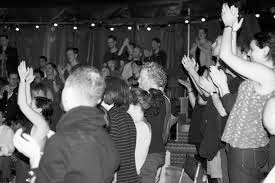Oh No, Another “Premature O”

What is better than attending a performance when actors or dancers or musicians are connecting with the audience? We sit, shoulder to shoulder, transformed by the magic; quiet – cell phones off (mostly), polite to our neighbors and respectful of the performers; transported by the experience.
And what can be worse than the person in front of you standing up, blocking your view, and making noise while the music is still playing before the performers exit the stage?
Yet, this is what is happening, almost nightly in theaters, concert halls and other performing spaces as audiences, in a new bizarre ritual, award every performance, no matter what the quality, an immediate standing ovation.
I personally enjoy the well-choreographed curtain call to Broadway show music composed for that purpose; the excitement builds as the performers reenter the stage in sequence from extra to lead. The better the performance, the more excitement; the more joy in participating by wildly clapping or clapping in unison (Europe), whistling or ‘whooping.’ And sometimes, when the villain appears, providing a mock expression of distaste by hissing. The fourth wall is down and we become part of the performance.
The concert curtain call features the conductor’s initial reentrance, hand in hand with the soloist who is applauded by the conductor and by the musicians who shuffle their feet or click their bows against music stands (their form of applause). This ritual is followed by the conductor pointing to (or hugging) the concertmaster and the other instrumentalist whose exemplary playing contributed to the overall work and in a final gesture of conducting, the maestro directs the full orchestra to stand to the adulation of the audience.
Or what is more satisfying, and sensual, then experiencing dancers, hand in hand, sweat pouring, costumes soaked, moving downstage while a designated dancer whispers a sign causing the ensemble to bow in unison?
For me, these traditions are an important part of the live performance. Unfortunately, these days my view is blocked by the premature standing ovation, forcing me to either stand (and perpetuate the misdeeds upon those in the row behind) or to sit glumly missing the activities on stage.
Why is this happening?
I am not a traditionalist…yes, I am a traditionalist; but I too have applauded after the first movement of Gershwin’s Piano Concerto, a piece so exciting that I can’t help being swept up each time I am in attendance. Applauding between movements of a symphony or during a great solo turn by a dancer or when the star actor enters the stage for the first time add to, not detract, from the audience/performer experience.
Why do I object to the “premature O?” First, as mentioned, it deprives me from experiencing an important part of the performance; second, when it’s an empty ritual it loses its importance. Besides, if there is no standing ovation (because perhaps I have influenced the reader) the performers may mistakenly think the performance was subpar.
So let’s try this: If the performance warrants it, clap your heart out and when the performers have taken their umpteenth curtain call, stand and go wild. If not, let’s have some respect for the person behind you and enjoy one the best parts of a live performance.
James Abruzzo is a management consultant to arts organizations and an experienced concert attendee.






